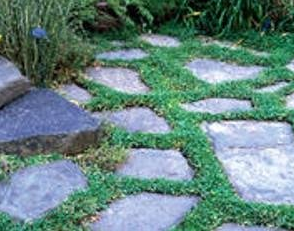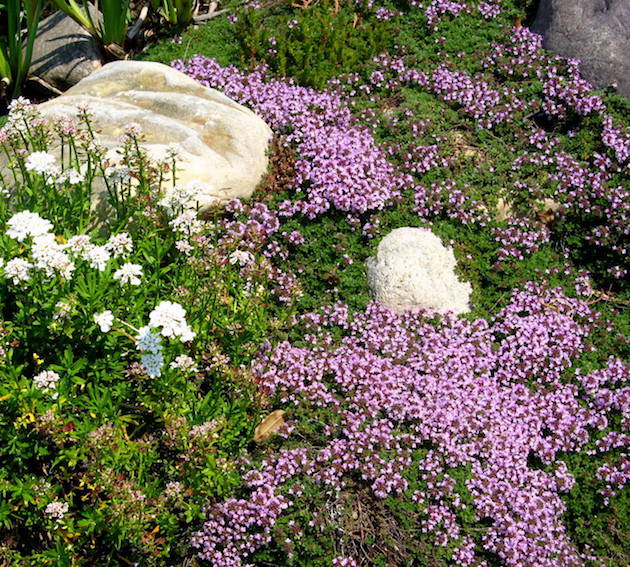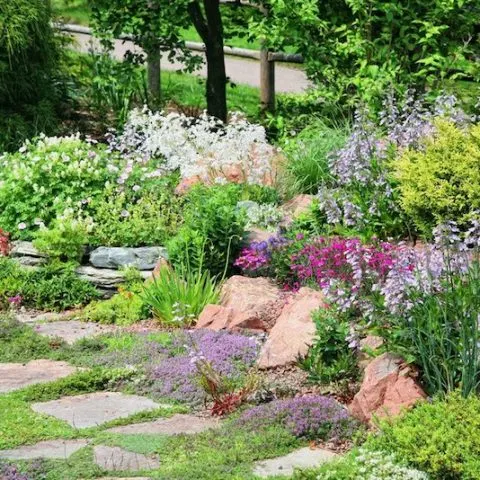Foodscape Your Yard With Beneficial Groundcover Plants!
Often overlooked, ground cover plants are worth considering for gardens, yards and landscapes. Unlike grass, edible ground cover plants not only beautify your yard and reduce maintenance, many are also edible and medicinal!
Don’t Want to Eat Ground Cover Plants? No Problem, These Also Have Ornamental Landscape Benefits
Not everyone likes the idea of eating plants low to the ground. If you have dog/s like we do, edible ground covers are best planted outside the dog’s range. Our electric dog fence spans a large area, so we’re limited on where we can plant and harvest edible ground cover plants.
Another option for dog owners would be to plant edible ground cover plants in containers. You can plant them as companion plants for a larger plant, or as an entire large planter of just growing edible ground cover plants. These can be harvested like you would microgreens.
We’ve even pulled chickweed from our yard and placed into pots so that we can consume it worry-free. Yep… planting weeds in pots, but it’s edible weeds with benefits!
In recent times of concerns around shortages of food and staples, more people are interested in growing their own food and learning survival skills such as foraging for food. One such skill is to learn more about the plants around you and their uses and benefits. Another is to plant a garden and edible landscape plants such as edible hedges.
Edible ground cover plants enhance landscapes, manage weeds, retain soil and expand your food production areas.
Benefits of Growing Groundcover in Pots
- Keeps plants away from pet “areas”
- Provides an attractive arrangement/soil cover for other larger plants/planters
- Easier to harvest clippings for salads, sandwiches and soups
No dogs? Then edible ground covers may be an especially beneficial option for you to expand your food production while serving your landscape aesthetics.
You can grow edible ground cover plants in pots for a pet free solution that’s easy to harvest.

Edibles Beyond the Garden
There’s no need to restrict growing food to the vegetable patch! We’re a bit obsessed by finding and encouraging food sources that are often overlooked.
If we had bundles of parsley, cilantro or watercress growing in tufts in our yard, chances are we wouldn’t just pull them as weeds. Yet most people do that all the time with other perfectly viable edibles.
The following is a list of plants that have edible and/or medicinal benefit and can be used as ground cover.
This list includes commonly cultivated ground covers as well as those that voluntarily grow wild in lawns, meadows or woods. We’re considering any low-growing plant that grows and spreads well and that’s edible, often with medicinal benefits.
Some, such as the Mexican sour gherkins, aka cucamelons, are generally grown as trellised vines. However, vine plants such as cucamelon and others in the cucurbita (squash) family can also happily cover a lot of ground growing horizontally.
If you have a lot of space to cover in a full sun area, cucurbitaceae plants can serve as edible ground cover for summer.
From dandelion to wild violets… chickweed to clover, there are all kinds of natural and cultivated edible ground covers worth growing.
Function and Beauty with Benefits
Often overlooked, ground cover plants are a worth considering for gardens, yards, and even pots. Unlike grass, ground cover plants not only beautify your yard and reduce maintenance, they can also be edible and medicinal!
If you have dogs like we do, edible ground covers are best planted outside the dog’s range if you plan to eat it. Our electric dog fence spans a large area, so we’re limited on where we can plant edible ground cover plants.
Another option for dog owners would be to plant edible ground cover plants in containers. You can plant them as companion plants for a larger plant, or, as an entire large planter of the edible ground cover plant of choice.
We’ve even pulled chickweed from our yard and placed into pots so that we can consume it worry-free. Yep… planting weeds in pots! But… it’s edible weeds with benefits!
Ground cover crops can be harvested for salads, soups and sandwiches by trimming like microgreens.
Edible ground cover plants enhance landscapes, manage weeds, retain soil and expand your food production areas.
Edible Ground Cover Plants
25 Natural and Cultivated Ground Cover Plants
- Alpine Strawberries, Fragaria vesca
- Bugleweed, Ajuga reptans – young shoots raw in salads
- Chickweed, Stellaria media
- Clover, trifolium
- Creeping Jenny, Lysimachia nummularia,
- Dandelion, Taraxacum officinale
- French sorrel, Rumex scutatus
- Ground Ivy, Glechoma hederacea, aka catsfoot
- Henbit, Lamium amplexicaule
- Marjoram, Origanum majorana, O. vulgare aureum & O. mounding marjoram
- Mexican sour gherkin, Melothria scabra, aka cucamelon
- Mints, Corsican mint
- Nasturtium, Tropaeolum
- Okinawa Spinach, Gynura bicolor
- Oregano, Origanum vulgare humile, aka creeping oregano
- Plantain, Plantago major
- Purslane, Portulaca oleracea
- Rock cress, Subrieta deltoidea
- Rosemary, Rosmarinus officinalis prostratus
- Sage, Salvia officinalis
- Sweet Potato Vine, Ipomoea batatas
- Thyme, Thymus prostratus, and Thymus serpyllum, aka creeping thyme
- Verbena / Vervain – Glandularia canadensis
- Wild Violets, Viola sororia
- Wintergreen, Gaultheria procumbens, aka creeping wintergreen
- Wood Sorrel, Oxalis stricta
Favorite Edible Ground Cover Plants
Alpine Strawberries
Fragaria Vesca Sempervirens, commonly called Wild Strawberry or Woodland Strawberry. These grow wild and are also cultivated to grow as a groundcover in select landscape areas.
By Renee Shepherd of ReneesGarden.com
These are a special ground cover for smaller areas as they stay put and won’t self-propagate via runners.
Considered a gourmet treat in French cuisine, Alpine strawberries produce a delightful berry. Seven to eight mature Alpine plants will yield approximately one cup of berries several times a week on a continuous basis throughout the summer.
Whenever you harvest strawberries, you may also want to harvest strawberry leaves for tea and salads!
8 Alpine strawberry plants can yield around a cup of berries several times a week throughout the summer.
~SOURCE: ReneesGarden.com
Bugleweed – Ajuga reptans
One of our favorites for partial shade ground cover is the low-growing ajuga, known botanically as ajuga reptans. Though not really minty in flavor or aroma, ajuga is in the mint family, and as with all mints, ajuga is edible with medicinal properties.
We love the beautiful purplish green leaves and abundant purple flowers.
We planted our ajuga in landscaped areas around our sidewalk. Now we’re finding volunteer clumps in other areas of the yard and woods around us.
Ajuga is designed to thrive and so it can be be invasive, but ours hasn’t spread aggressively. So far, we’re enjoying the fact that nature is helping with the planting of this in other locations now.
WARNING: “Spreads easily” can be another way of saying “invasive”, so if you don’t want volunteer plants cropping up, this may not be for you.
Ajuga, (ajuga reptans), aka bugleweed, spreads easily for a great groundcover in partial sun or mostly shade.
Bugleweed – Ajuga Reptan – Medicinal Properties
Beside its horticultural use as an attractive spreading ground cover in rock gardens and other types of gardens, bugleweed is useful medicinally.
- Astringent
- Sedative, can calm anxiety
- Reduce heart palpitations
- Cough suppressant[1]https://www.encyclopedia.com/doc/1G2-3435100133.html

Marjoram – origanum majorana
A wonderful lawn substitute, marjoram is a variety of oregano with a milder citrusy pine flavor. Bees and butterflies love the lilac flowers on this creeping, tiny-leafed, plant.
Marjoram is an edible ground cover alternative to a lawn. You can even mow it like grass, which encourages more rapid growth.
Marjoram, (origanum majorana):
Bees love the lilac flowers of marjoram and the leaves add a subtle citrusy pine flavor to cooking.
The mounding marjoram is a low growing, ground-hugging aromatic herb. Marjoram is perfect for landscape ground cover with edible, culinary and medicinal benefits.
Milder in flavor and aroma than oregano, marjoram is a different species as oregano but the same genus.
Mowing marjoram helps to keep it flat and soft to walk on.
~MountainValleyGrowers.com
The Best 3 Creeping Oregano Plants to Replace Grass as Ground Cover:
- The brilliant green Creeping Oregano, Origanum vulgare humile, (formerly, Origanum compactum nanum)
- Golden green Creeping Golden Marjoram, Origanum vulgare aureum is a golden green in spring and fall and dark green in summer
- Dark green Mounding Marjoram, Origanum marjorana, aka ‘Betty Rollins’)
Corsican Mint – mentha requienii
Medicinal Properties
- Antiseptic
- Headaches
- Fevers
- Digestive disorders
We really like this Corsican Mint, mentha requienii, for an edible ground cover. It’s tiny delicate leaves create a lush carpet of soft green fragrance, perfect for small accent areas or in between stone paths.[2]https://pfaf.org/user/Plant.aspx?LatinName=Mentha+requienii
For more on growing mint here.


Nasturtium – Tropaeolum majus
Nasturtium Common Names
- Garden nasturtium
- Indian cress
- Monks cress
We grow nasturtiums each year and love their hardy resiliency, easy care and summer long blossoms. Nasturtium blossoms add vivid hues of orange, yellow or red to your gardenscape. But more than that, they add food value.
Beauty aside, nasturtium leaves and blossoms have a pleasing peppery flavor that can spice up a salad, soup or sandwich. You can also cook nasturtiums. Even the seed pods can be eaten as a virtual gourmet caper.
They’re one of our favorite edible flowers to grow and enjoy each year.
NASTURTIUM (tropaeolum majus):
Enjoy the flowers, stems, leaves, and seeds of this lovely edible ground cover plant.
Okinawa Spinach – Gynura crepioides
A beautiful, vigorous, perennial vegetable the purple-tinged Okinawa spinach forms a dense, non-vining, edible ground cover that grows well in full sun or partial shade.

As a food, Okinawa spinach is a spinach substitute, similar to longevity spinach (gynura procumbens, making a nice addition to salads, and can also be eaten cooked. It is purported to have properties that help lower cholesterol, and is grown commercially as a vegetable in China.
You may enjoy checking out our list of perennial vegetables.

Sweet Potato Vine – Ipomoea batatas
Sweet potato roots are widely known to be delicious and nutritious. A staple food, that’s long lasting and easy to store, sweet potatoes are a rich source of vitamins and minerals.
However, there’s far more to this plant that meets the eye! While the wonderful orange tuber is hidden underground, don’t neglect the nutrient treasure in plain sight!
Nutritionally, sweet potato greens are similar to spinach. However, sweet potato leaves are lower in oxalic acid content, which gives some greens like spinach and chard a sharper taste. Oxalic acid also has its pros and cons with opposing and confusing information on whether it’s best cooked or raw.
Sweet potato leaves are more nutritious than the already nutrient-dense sweet potato root.
Beyond that, sweet potato greens make a lovely ground cover. Even the ornamental sweet potatoes are edible, but the potatoes may not be as orange or as sweet.
Sweet potato leaves have 3x more vitamin B6, 5 times more vitamin C, and almost 10 times more riboflavin than sweet potato tubers.

Thyme – thymus serpyllum
There are several varieties of thyme and all are lovely and edible.
The Elfin Thyme, thymus serpyllum—is a fast-spreading creeping thyme. Despite it’s delicate appearance, elfin thyme is happy in most soils and can even survive dry and windy conditions.
Thymus serpyllum is especially lovely planted in and around rocks, and has extra benefit as being amongst the plants that repel ticks.
Elfin thyme (thymus serpyllum), is a creeping variety of thyme for a lovely, edible, fast spreading ground cover, that flowers in a variety of colors, and can fit into small spaces.

Edible Ground Covers for Shade
Here are more wonderful edible ground covers that grow best in shade or partial shade.
Edible Yard Gardens
Once you get into food gardening, it’s natural to want to plant as many edible plants as possible. Edible landscaping that incorporate edible plants into attractive landscapes are growing in popularity.
Of course… if for you, it’s about growing flowers and plants for beauty over food… that’s fantastic! We’re for all gardens and gardening… whatever kind of plants you favor.
But remember… even then, many flowers are edible and/or medicinal.
There’s nothing quite like the delight and freedom that comes from walking out your door and harvesting your dinner from plants you’ve grown into food.
How to Choose What Plants to Grow – Consider:
- Beauty – soul food
- Nutrition – body food
- Medicinal benefits – health food
- Pollinators – bird & bee food
- Natural habitat – plant food
The best of both worlds are plants that have beauty and benefits.
When growing space is limited, as is ours, it’s all the more important to decide based on benefits. So when planning our gardens, we consider crops we love to eat, coupled with those that have the most benefits.
That’s one of the reasons we’re growing dandelions. They can be greens, beverages, and medicine, plus great for pollinators.
From bee food to people food… soil retainers to insect repellents… medicine and beauty, planning and planting with purpose in mind creates so many more benefits.
Contributions from the Community
Below are additional plants mentioned by our GardensAll Facebook community that are not already in the lists above:
- Chamomile, matricaria chamomilla
- Cleaver, galium aparine
- Lemon balm, melissa officinalis
- Liriope, liriope muscari, aka Lilyturf
- Money plant, lunaria
- Purple dead nettle, lamium purpureum (see also weeds with purple flowers)
See purple dead nettle uses and benefits.
Edible landscape designs blend food and medicinal benefits with beauty.


Let’s keep on growing!
We are an online gardening publication sharing all things garden related! Including urban farming, family gardening, homesteading, gardening for profits, and more. We’re all about growth!
References








